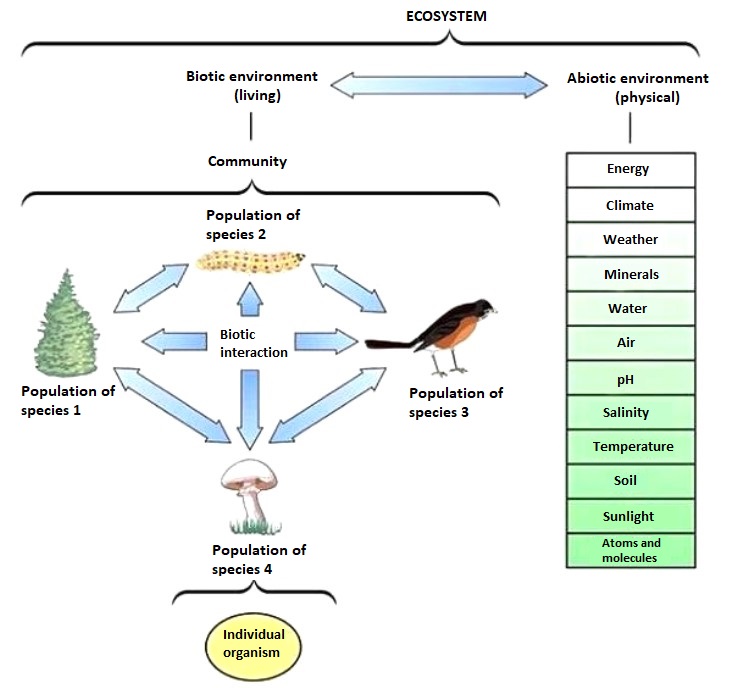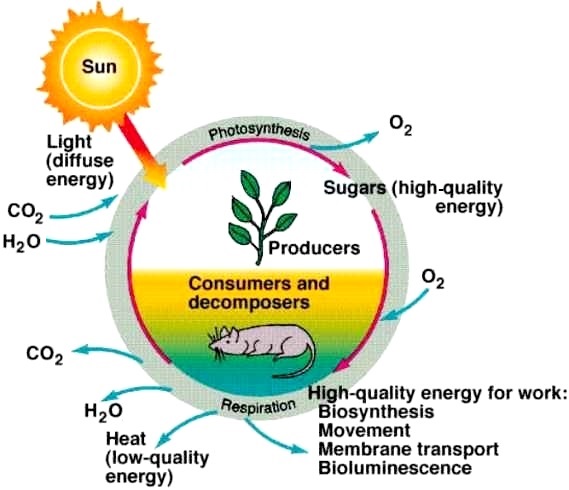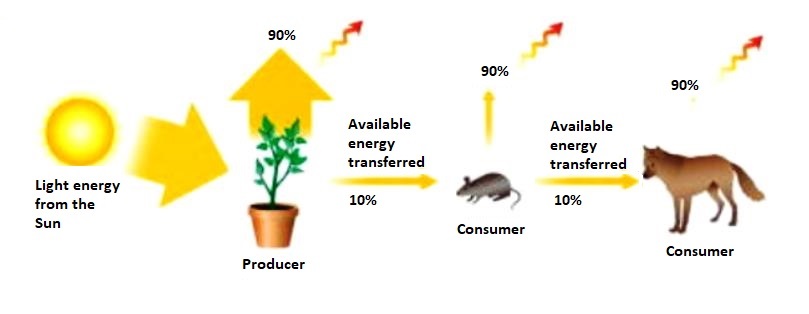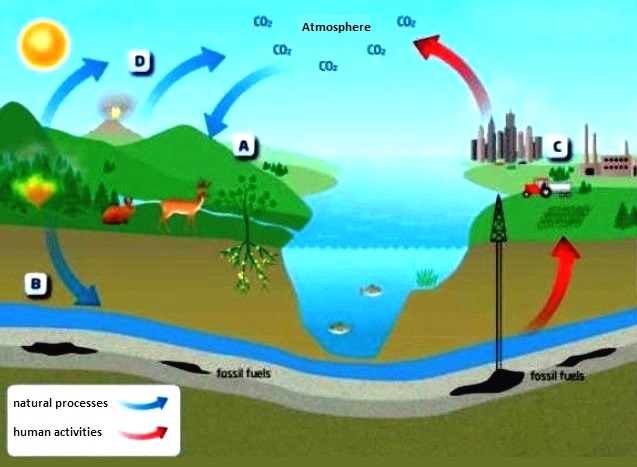Key Concepts
A functional system that includes an ecological community of organisms together with the physical environment, interacting as a unit. Ecosystems involve both biotic (living) components and abiotic (nonliving, physical) components (Fig. 1). Also termed ecological systems, ecosystems are characterized by a flow of energy through food webs, production and degradation of organic matter, and transformation and cycling of nutrient elements. The production of organic molecules serves as the energy base for all biological activity within ecosystems. The consumption of plants by herbivores (organisms that consume living plants or algae) and detritivores (organisms that consume dead organic matter) serves to transfer energy stored in photosynthetically produced organic molecules to other organisms. Overall, the cycling of elements is coupled to the production of organic matter and the flow of energy. See also: Algae; Ecological communities; Ecology; Energy; Environment; Food web; Freshwater ecosystem; Photosynthesis; Plant

Autotrophic production
All biological activity within ecosystems (Fig. 2) is supported by the production of organic matter by autotrophs (organisms that can produce organic molecules from simple inorganic substances, such as carbon dioxide and inorganic nitrogen). More than 99% of the autotrophic production on Earth is provided through photosynthesis by plants, algae, and certain types of bacteria. Collectively, these organisms are termed photoautotrophs (autotrophs that use energy from light to produce organic molecules). In addition to photosynthesis, some production is conducted by chemoautotrophic bacteria (autotrophs that use energy stored in the chemical bonds of inorganic molecules, such as hydrogen sulfide, to produce organic molecules). The organic molecules produced by autotrophs are used to support the organism's metabolism and reproduction, and to build new tissue. This new tissue is consumed by herbivores or detritivores, which in turn are ultimately consumed by predators or other detritivores.

Terrestrial ecosystems, which cover 30% of the Earth's surface, contribute a little over one-half of the total global photosynthetic production of organic matter—approximately 60 × 1015 grams of carbon per year. Oceans, which cover 70% of the Earth's surface, produce approximately 51 × 1015 grams of carbon per year. See also: Terrestrial ecosystem
Whereas most ecosystems receive sunlight to support photosynthesis, photosynthetic production does occur in the deep ocean and in caves. In a few unique ecosystems, such as deep-sea thermal vents and caves, the production of organic matter is carried out by chemoautotrophic bacteria. These ecosystems harbor surprisingly diverse communities that function in the complete absence of sunlight. See also: Bacteria
Heterotrophic production
The organic matter produced by autotrophic organisms is ultimately consumed by heterotrophs (organisms that obtain energy and nutrients by consuming other organisms). Globally, most organic matter produced by plants and algae is consumed by detritivores. Herbivores consume only about 5% of photosynthetic production, fire destroys another 5%, and a small fraction of autotrophic production is lost through burial within the Earth's crust (to potentially become fossil fuels). The proportion of photosynthetic production consumed by herbivores can vary considerably among ecosystems. In terrestrial ecosystems, much plant tissue is structural molecules, such as cellulose and lignin, that are difficult or impossible for most organisms to digest. In aquatic ecosystems, in which algae dominate, a much greater proportion of photosynthetic production is consumed by herbivores. Algae have little in the way of structural molecules and contain more molecules that can be consumed by grazing organisms. See also: Biomass; Ecological succession
Food webs
Organisms are often classified according to the number of energy transfers through a food web or food chain (Fig. 3). Photoautotrophic production of organic matter represents the first energy transfer in ecosystems and is classified as primary production. Consumption of a plant by a herbivore is the second energy transfer; thus, herbivores occupy the second trophic level, also known as secondary production. Consumer organisms that are one, two, or three transfers from photoautotrophs are classified as primary, secondary, and tertiary consumers. Moving through a food web, energy is lost during each transfer as heat, as described by the second law of thermodynamics. Consequently, the total number of energy transfers rarely exceeds four or five; with energy loss during each transfer, little energy is available to support organisms at the highest levels of a food web. See also: Ecological energetics; Food web; Heat; Trophic ecology

Biogeochemical cycles
In contrast to energy, which is lost from ecosystems as heat, chemical elements (or nutrients) that compose molecules within organisms are not altered and may repeatedly cycle between organisms and their environment. Approximately 40 elements compose the bodies of organisms, with carbon, oxygen, hydrogen, nitrogen, and phosphorus being the most abundant. If one of these elements is in short supply in the environment, the growth of organisms can be limited, even if sufficient energy is available. In particular, nitrogen and phosphorus are the elements most commonly limiting organism growth. This limitation is illustrated by the widespread use of fertilizers, which are applied to agricultural fields to alleviate nutrient limitation. See also: Biogeochemistry; Fertilizer
Nitrogen cycle
Nitrogen commonly limits the rate of primary production in terrestrial, freshwater, estuarine, and oceanic ecosystems (Fig. 4). In one turn of the biogeochemical cycle of nitrogen, (1) cyanobacteria and certain types of eubacteria transform atmospheric dinitrogen (N2) into organic molecules, such as protein (nitrogen fixation); (2) organisms are consumed by other organisms, and organic nitrogen is converted into ammonium as a waste product (decomposition); (3) ammonium either is assimilated by plants, algae, and bacteria into organic forms or is converted to nitrate by chemoautotrophic bacteria (nitrification); and (4) nitrate is converted back to dinitrogen by anaerobic bacteria (denitrification). Whereas nitrogen is very abundant in the atmosphere as dinitrogen, only a select group of organisms can transform dinitrogen into organic forms (amino acids), and the transformation requires a lot of metabolic energy. Humans have greatly impacted the global nitrogen cycle by doubling the amount of ammonium, nitrate, and organic nitrogen in the environment through the widespread use of fertilizers and combustion of fossil fuels. This massive change in nitrogen forms has led to problems with acid precipitation, alterations of global patterns of primary production rates, increased production of nitrous oxide (a greenhouse gas), and pollution of aquatic ecosystems. See also: Human ecology; Nitrogen; Nitrogen cycle; Nitrogen fixation; Nitrogen oxides; Water pollution

Phosphorus cycle
Phosphorus also commonly limits primary production. In contrast to nitrogen, phosphorus lacks an atmospheric phase. The primary source of phosphorus to ecosystems is the weathering of the Earth's crust. This inorganic phosphorus is then assimilated by plants, algae, and bacteria and is incorporated into organic forms, such as phospholipids and adenosine triphosphate (ATP). As organisms are consumed by other organisms, organic phosphorus is converted back to inorganic forms. Both organic and inorganic forms are slowly carried by water from plants and soils to streams and rivers, and ultimately to the world's oceans, where phosphorus is buried in sediments. The global phosphorus cycle is completed over long, geologic timescales when ocean sediments are compacted into rock and this new rock is uplifted onto continents. As with the nitrogen cycle, humans have dramatically impacted the phosphorus cycle by application of fertilizers. See also: Adenosine triphosphate (ATP); Phospholipid; Phosphorus; Phosphorus cycle
Carbon cycle
Carbon cycles between the atmosphere and terrestrial and oceanic ecosystems (Fig. 5). This cycling results, in part, from primary production and decomposition of organic matter. In turn, rates of primary production and decomposition are regulated by the supply of nitrogen, phosphorus, and iron. The combustion of fossil fuels is a modern-day change in the global cycle that releases carbon that has long been buried within the Earth's crust to the atmosphere. Carbon dioxide in the atmosphere traps heat on the Earth's surface and is a major factor regulating the climate. This alteration of the global carbon cycle along with the resulting impact on the climate, that is, global climate change, is a major issue under investigation by ecosystem ecologists. See also: Air pollution; Applied ecology; Global climate change






